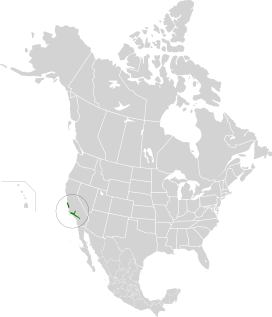California montane chaparral and woodlands facts for kids
Quick facts for kids California montane chaparral and woodlands |
|
|---|---|

Montane chaparral and woodlands of Big Sur
|
|
 |
|
| Ecology | |
| Realm | Nearctic |
| Biome | Mediterranean forests, woodlands, and scrub |
| Borders |
List
|
| Bird species | 222 |
| Mammal species | 78 |
| Geography | |
| Area | 20,400 km2 (7,900 sq mi) |
| Country | United States |
| State | California |
| Conservation | |
| Conservation status | Vulnerable |
| Global 200 | Yes |
| Habitat loss | 2.7345% |
| Protected | 63.53% |
The California montane chaparral and woodlands is a special natural area in California. It's like a big mountain home for many plants and animals. The World Wildlife Fund describes this area. It covers about 7,900 square miles (20,400 sq km) of mountains. You can find it in southern and central California. This ecoregion is part of a larger area called the California chaparral and woodlands. It belongs to a type of environment known as Mediterranean forests, woodlands, and scrub.
Contents
Geography and Climate
This ecoregion stretches across many mountain ranges. These include the San Bernardino Mountains and San Gabriel Mountains. It also covers the Santa Monica Mountains and Santa Lucia Mountains. The climate here is called a Mediterranean climate. This means summers are hot and dry. Winters are cool and wet.
The mountains have many different heights. This, along with the special climate, creates various natural areas. You can find everything from chaparral (dense shrubs) to mixed evergreen forests. Some very high places even have alpine tundra, which is like a cold, treeless plain.
Ecology
Plants (Flora)


At lower mountain heights, you'll mostly see shrublands. Common plants include Chamise and different types of Manzanita. There are also scrub oaks. This ecoregion is home to several kinds of oak trees. These include coast live oak and canyon live oak. Some trees, like the Engelmann oak, are found only here. These are called endemic species. There are also eight types of endemic conifer trees.
Higher up, you'll find different manzanita species. There are also "closed-cone pine forests." A special tree called Bigcone Douglas-fir lives in some of these areas. You can also see mixed evergreen forests at heights from 4,500 to 9,500 feet (1,370 to 2,900 meters). These forests have trees like incense-cedar and foothill pine. Other trees include sugar pine and white fir. Even higher, up to 11,500 feet (3,500 meters), you'll find subalpine forests. These have trees like limber pine and lodgepole pine.
A plant called Hesperoyucca whipplei, or Chaparral Yucca, is very common. You can see it in the lower parts of this climate zone.
Animals (Fauna)
This region is home to many small animals. These include the western fence lizard and white-eared pocket mouse. Several types of kangaroo rat also live here. The monarch butterfly visits this area in winter. They settle near the coast.
Larger animals also live here. You might see black bears and mountain lions. Other predators include bobcats, coyotes, and ring-tailed cats.
Conservation Status
About 30 percent of the California montane chaparral and woodlands is still natural. About 70 percent has been damaged by human activities. This natural area is mainly threatened by new buildings and farms. It's also harmed by animals grazing and trees being cut down. Too many wildfires and planned fires also cause problems.
This is a big issue, especially in Southern California. It's also a problem in Monterey County. Many people live in cities within this ecoregion. These include Monterey and Santa Barbara. The foothill areas of cities near the San Gabriel Mountains and San Bernardino Mountains are also affected.
Groups are working to protect the remaining natural areas. State and federal agencies, like the U.S. Forest Service, are helping. They try to protect endangered trees and special plant communities. Much of this area is inside national forests. These include the Los Padres National Forest and Angeles National Forest.
Air pollution has badly affected some forests. However, air quality has gotten better in southern mountain areas. This is thanks to rules and actions to reduce smog since the late 1900s.
Images for kids


